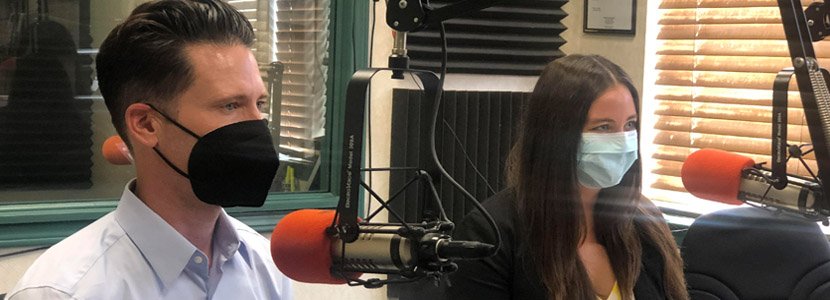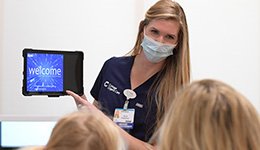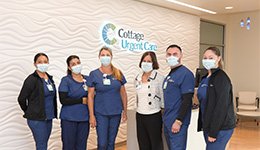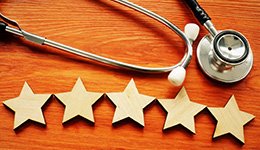Urgent Insights: When Cottage Urgent Care is Right for You
 Ryan Skrupky, MD and Taryn O’Connell
Ryan Skrupky, MD and Taryn O’Connell
A 5-week series with Ben Heighes featuring:
Ryan Skrupky, MD
Medical Director for Cottage Urgent Care
Taryn O’Connell
Administrative Director, Cottage Urgent Care Operations
Scheduled Topics

The Urgent Care Experience - What’s Changed?
Find out about the typical experience a patient can expect at Cottage Urgent Care, how this experience differs from other centers and how patients have been responding to Cottage Urgent Care centers so far.
Listen to the Interview
Segment 1 Transcript
What is the typical experience a patient can expect at Cottage Urgent Care?
Taryn
- Our experience really starts with where we are located, which is within popular retail centers. The goal is for you to be able to access us conveniently based upon where you are already going about your daily lives, instead of needing to find us when you’re having a bad day. Once you arrive, you are immediately greeted by a CC at the door and often roomed with no wait time. The CC stays with you for the duration of the visit and relays your information to our NP. This really reduces hand-offs between multiple people and the amount of times you are repeating yourself.
- We also offer what I like to think of as our special touches – most popular are our coffee and tea and warm blankets for patients.
- While we aim to have a good experience during the visit, we also want it to be quick! We have an average turnaround time of 30-45 minutes depending on what you are there for.
- Ryan would you like to share some of the testing and medication offerings that tie into patient experience?
Dr. Skrupky
- Sure. For testing we offer on-site POC testing that gives results within 15 minutes for urgent cares issues like UTI, strep pharyngitis, mononucleosis, Abbot COVID testing and on-site x-rays to identify fractures.
- We also have an in-clinic formulary. For example, we have medication for nausea or a bad poison oak reaction AND pre-packed prescriptions that allow you to complete your care and avoid a trip to the pharmacy. PPM are offered at a low cost of about $10 realizing that many patients would like this convenience.
Taryn
- Speaking of cost, that is definitely another common question from consumers. Based upon our scope of services we are able to offer a set price for our visits, so no surprise billing on the back end! For most patients this means that they pay the cost of their co-pay with their insurance, and we also offer a $189 cash pay rate as well.
How does this experience differ from other urgent care centers?
Taryn
- Great question. Some of the features that I touched upon above, such as being located in a retail setting, offering an average of a 30-45 minute total visit time and set pricing are the biggest differentiator between this type of urgent care model and more traditional urgent care centers.
- One key factor in how we accomplish our quick door-to-door times is offering a more limited scope of services than a lot of the traditional urgent care models. I will turn it over to Dr Skrupky to walk us through how our model differs from the more common tradition model.
Dr. Skrupky
- Yeah so there are pros and cons to both types of models. Most UCs in central coast are what we call “traditional models”. The big difference between what we offer and the traditional model is that we don’t partially work up and treat a patient who we know from the get-go will need emergency care.
- Traditional models tend to offer a wide scope of services which may include IV treatments, comprehensive lab testing and a variety of advanced imaging modalities like US or CT.
- The downside of a wide scope and extensive testing is a longer visit sometimes a few hours which has a downstream impact of delaying care for new patients who are now waiting to be seen in the waiting room, by the way it costs more too.
- We decided to focus entirely on urgent care conditions that we can treat expeditiously and if we can’t treat it at our center providers use their clinical experience to act as navigators to get you to the right place quickly.
- Let me use a case of appendicitis to highlight the differences between these two models of healthcare.
- So let’s walk through the “traditional model” first. A provider sees a patient after they’ve spent time in the waiting room, after the evaluation they will likely undergo lab testing which will take about an hour, they will likely receive IVFs and maybe medications BUT the diagnosis of appendicitis often requires use of a CT scan and surgery in a hospital to cure. On the surface while this traditional model may meet the patient’s need in the moment they’re ultimately sent to the ER for completion of care many hours later which now puts them in the position of repeating themselves when they arrive at the ER as well as many aspects of their medical. This duplication of efforts is inefficient, can delay care and leads to two bills.
- In our model this patient would be seen in most cases with no wait, the provider evaluation would take about 15 minutes at which point the concern for appendicitis would be discussed and the provider would navigate them promptly to an ER for work up and surgical treatment. This approach saves the consumer time and money and is perhaps safer by getting them to the location that can meet their needs quicker.
How have patients been responding to the urgent care centers so far?
Taryn

When to Go to Urgent Care
Learn what types of conditions are commonly treated at our centers, what types of testing and procedures are offered, and what happens when a patient presents with needs outside of the services we offer.
Listen to the Interview
Segment 2 Transcript
What types of conditions are commonly treated at your urgent care centers?
Taryn
- The most common conditions that we treat include COVID-19 assessment and testing, x-ray services for sprains and minor fractures, rashes, UTIs, earaches, sore throat, minor lacerations and other minor procedures – for example, incision & drainage of a simple abscess.
- Of course COVID-19 visits are not something we forecasted when you planning this project, and one thing that is interesting is that typically upper respiratory infections - most commonly influenza - would be one of our top conditions treated. However, with all of the measures to stop the spread of COVID, we barely saw any influenza cases at all this year.
- While these are a few examples of conditions we treat, our scope is very focused on urgent care conditions, Ryan can you speak to this?
Dr. Skrupky
- Yeah so what our scope doesn’t include would be ongoing primary care or chronic care, comprehensive lab testing or advanced imagining. Should you need these types of services we would help direct you to the appropriate setting.
- You might ask why we made this choice and for us it was a way to keep our waiting room empty, deliver on what we have marketed as quick visits and to keep costs low. By the way, when you decide to focus on a set of conditions and services you become really good at them and do it consistently.
What types of testing and procedures do you offer?
Dr. Skrupky
What happens when a patient presents with needs outside of the services you offer?
Taryn
- For more complicated procedures, for example if our providers asses a laceration and determine that it either needs plastic surgery or that a tendon injury might be involved, they will educate the patient on their concerns and then promptly refer to an ER.
- Additionally, there are some conditions that will always require emergency level care, a good example of this is chest pain.
- However, I don’t want people to be discouraged not to show up to one of our centers, Ryan can you talk a little bit about how our patient navigation works?
Dr. Skrupky
- Sure. Well let’s be real here, the healthcare system is complicated. Patients aren’t always going to know what the most appropriate access point is for their medical condition and so we want to help here.
- If someone arrives with a condition that would be better served by ongoing primary care or the emergency department or a specialist, we will help you navigate the system. When this occurs, we don’t waste time do unnecessary tests, we discuss your next step early and navigate you in that direction, in the case of primary care or a specialist we have referrals lists of physicians who have committed to seeing Cottage UC patients in a timely manner.
Are there other service offerings at your urgent care centers that the audience should know about?
Taryn
- Yes absolutely, I’d like to share about some of our convenience services that we offer for what we call an “A La Carte” price. As we talked about in the first segment, offering a convenient option for busy people is one of our main goals with these centers. Therefore, we offer some cash-pay services to provide patients with an option available outside of the typical hours of a doctor’s office. A few examples of this include Sports Physicals, TB screening and asymptomatic COVID testing for travel or gatherings.
- We are also expanding into Occupation Health, with a goal of offering physicals and drug screens to local employers hopefully in the near future as well.

The Urgent Care Pricing Model
Find out about the traditional Urgent Care pricing model and how this differs from the Cottage Urgent Care pricing structure.
Listen to the Interview
Segment 3 Transcript
Can you set the stage for us on traditional urgent care pricing and access?
Taryn
- I think by now most people listening have heard the term “surprise medical bill” – which has been a hot topic for a few years now. Essentially, how this works is that a patient thinks that they are paying up front for one service (e.g. a surgery), however they get a variety of bills on the back-end for additional services such as supplies, fee for the anesthesiologist, etc.
- Additionally, as a consumer – or even as someone who works in healthcare – if you try and figure out upfront what your total cost of care will be, it is nearly impossible. This is not because people in healthcare want to take advantage of people in a vulnerable time in life, it is because the healthcare system has become so complex in the United States.
- I could spend this entire series getting into the “why” behind this, so we will have to save that for another time and for now I will turn it over to Ryan to share a little bit of his perspective as a clinician.
Dr. Skrupky
- Yeah I want to emphasize that our pricing model is a big deal! As a clinician patients ask me all the time, how much is this going to cost? In the emergency room environment and most urgent cares the honest answer is “I don’t know” or if I give an answer, I’m wrong.
- So, what does transparent pricing mean from a patient’s perspective? If patient seeks treatment for a sore throat which might involve a POC test or musculoskeletal injury which would need an x-ray and possibly splinting - the cost is the same and for self-pay its $189, no surprises!
There are a variety of different insurance plans out there and not all patients will want to pay cash, is the pricing structure the same if a patient wants to use their insurance?
Taryn
- Pretty much! For government payors – so patients with Medicare or CenCal – there is no out-of-pocket cost at all for our services. For patients with commercial insurance they will be asked to pay their co-pay upfront and then will not receive a bill on the back-end for “extra” services performed. Every service received in the urgent care fits into our one flat rate.
- It is important however for patient’s to arm themselves with information on their covered benefits. Our model simplifies things A LOT, but the healthcare system is still complicated so it’s important for people to plan ahead and know their benefits.
- The main situation I do want consumers to be aware of is if you have a high deductible health plan, because this is the situation in which we have no control over the patient receiving a bill on the backend if their deductible has not yet been met. For a lot of low healthcare utilizers – healthy people! – it is likely they probably have not met their deductible.
- I want to encourage everyone to take a few minutes when you can to familiarize yourself with your healthcare benefits, so that when you find yourself needing urgent care services you can easily make a decision that best fits your needs.
What factors lead Cottage to open multiple centers along the Central Coast?
Dr. Skrupky
- The number one reason Cottage choose to open these centers was based on need. A few years ago Cottage assembled a task team looking at our community and surrounding communities to understand the current state of healthcare access.
- It was clear that our region needed more primary care and more urgent care services.
- Just think about how big of a commitment Cottage made by meeting needs not just in our community but in communities from Cam to SLO.
- In addition to increasing access for urgent care conditions throughout the central coast, Cottage wanted to provide care in a different, more consumer-friendly way with high amenities, convenient locations and affordability. This bold decision has had the impact of strengthening the healthcare offered in each region.
Taryn
- Yeah that’s right. In addition to adding value in the services we provide within the walls of the urgent cares; we also believe our referral strategy is adding value to the local communities. Our referral strategy is again another way in which Cottage approaches our urgent care model differently. Rather than having a goal of referring all patients back into the Cottage system, we want to refer patients to healthcare services that are most convenient to them so that they have as few barriers possible to getting the healthcare that they need. To this end we have surveyed physicians in the local communities to develop comprehensive referral lists, which make it easy on our providers to make the best referral possible for each patient.

Cottage Urgent Care and the COVID-19 Pandemic
Hear about what it has been like opening up new Urgent Care centers during the pandemic and how COVID-19 has impacted the experience of patients.
Listen to the Interview
Segment 4 Transcript
Tell me what it has been like opening up new urgent care centers during the pandemic?
Taryn
- It forced us to adapt quickly to meet needs of the community The first shutdown occurred when there were only three of us on the urgent care team – for reference there are now ~150 people working for Cottage Urgent Care – and I remember talking on the phone with our manager and saying to each other, this needs to end soon because there is no way we can hire healthcare employees over Zoom… but then we did! And actually it worked out really well.
- Other than the majority of things – including our open houses – going virtual, rapidly adopting to new protocols while launching brand new urgent care centers kept us on our toes, Dr Skrupky definitely knows about this from his ER work as well.
Dr. Skrupky
- Yeah clinically we’ve had to pivot a lot as we learned about this new infectious disease by updating policies and safety guidelines.
- Fortunately, my co-director Dr. Flynn and I are emergency physicians and have been on the frontline from day one learning the new landscape and working with our amazing hospital leadership’s incident command center.
- We currently offer symptomatic car testing and if we are bringing someone into the center for a non-COVID complaint who screens positive at the door we test prior to entry with our 15 minute rapid abbot PCR test.
- For those with possible COVID undergoing a car evaluation we do vital signs and get an ambulatory pulse ox which helps us determine who needs to be referred to an emergency department.
- We will soon offer asymptomatic testing for travel.
How has COVID impacted the experience of the patients in your center?
Taryn
- Adapted to screening outside like many businesses were doing, the difference for us though is that people are coming to us for healthcare so we can’t turn them away if they screen positive to potentially having COVID-19. So the way we addressed this is by adding negative airflow rooms for patients who need to come inside (e.g. someone needing sutures) and bringing patients directly back to these rooms.
Dr. Skrupky
- Yeah it didn’t feel right to us to abandon these patients who needed care just because they concurrently had COVID when we knew based on science that we could care for them safely by using proper PPE and our negative airflow rooms.
Taryn
- Yeah exactly. With the Cottage Urgent Care Centers being part of Cottage Health, we really benefitted from having the expertise of Cottage’s Infection Prevention & Control team, as well as the Infectious Disease leaders helping our County through this pandemic, weigh in on all processes within the center. All patients who enter the urgent care centers can feel confident that the same level of thought and care has gone into our COVID-19 safety protocols as those that are in place in any of the 3 Cottage Health hospitals.
Do you offer COVID vaccines?
Taryn
- During the peak demand for vaccines we were fortunate to have the opportunity to offer in our Goleta and Buellton locations, however we have centralized all efforts within Cottage at the Drive-through clinic across the street for GVCH. It was really a privilege to be able to be part of the hope that the vaccines have brought to so many people after dealing with the extreme stress and challenges the pandemic has brought to all of us over the last year and a half.
- If you need help finding a vaccine visit myturn.ca.gov

Quality Assurance
Get an overview on how Cottage Urgent Care achieves the highest level of quality.
Listen to the Interview
Segment 5 Transcript
So we are here today to talk about quality, can you help give the listeners an overview on how quality is typically overseen in urgent care centers?
Dr. Skrupky
- I think one point I would want your listeners to appreciate is that unlike the hospital environment, there are no required quality metrics and so it would be easy when you’re opening multiple centers to not have this be a priority, but that is not the Cottage way. Quality and excellence is at the center of everything we do. When we began this journey we started with a strategy that would help us ensure that people receive the high quality of care that they have come to expect with the Cottage name.
That’s great to hear, so how does your model accomplish this?
Taryn
- Our model of care is a Nurse Practitioner- driven model with physician oversight. We see this as being the best of both worlds because staffing our centers with Nurse Practitioners is a great way to keep our costs to the patient at a slightly lower price point, while fully utilizing the skillset and licensure of these Advanced Practice Providers. We support our NPs in their practice with physician oversight and Medical Directorship by Dr Skrupky and his colleagues.
How does that oversight relationship work?
Dr. Skrupky
- We start by recruiting the best Nurse Practitioners. The relationship between the physician oversight and providers begins with an assessment of their procedural skills and clinical experience during the interview process. We’ve incorporated a 5-week orientation that includes a skills day focused on the procedures they will commonly perform such as laceration repair, abscess drainage and splinting. After they finish orientation and start working within our centers, we follow-up and discuss cases that they’ve had on a regular basis. I should mention that all of the NPs have easy access to a supervising physician when they’re working in a center. I’m proud to say that all of our supervising physicians are highly experienced board-certified hospital credentialed emergency physicians who work at Cottage.
- One of the things that surprised Dr Flynn and I during interviews when we were learning about how other urgent cares function is the limited contact providers have had with their previous medical directors and supervising physicians. Here at Cottage we want to ensure that our providers feel supported and can always reach a physician when needed.
What tools do you use to make sure that the level of quality you are striving for is achieved?
Dr. Skrupky
- It became apparent to us early on that we needed a robust dashboard with a variety of metrics to ensure that a standard level of care was delivered across all centers. When someone comes to our center in SLO we want them to receive the exact same care they would receive in Camarillo. Our dashboard is comprehensive, but to give you a small sample we track our antibiotic and opioid prescription rates. These are important measures for us to understand because they can affect antibiotic resistance patterns in local communities and addiction.
Taryn
- Yeah and in addition to our quality metrics we also closely measure metrics tied to our patient experience goals that we shared in earlier segments. So two of the most important examples of that are looking at our average door-to-door times at each center on a daily basis and also monitoring our patient satisfaction scores closely.
- Our commitment to the community is to have an average turnaround time of 45 minutes in the center – and I say average because there are certain visits, like repairing a laceration, that need to take longer to be treated appropriately – and we are consistently averaging times ~10 minutes faster than this.
- Our NPS score across all sites is 93/100… and to give some context Starbucks has an NPS score of 77 and Apple has an NPS score of 65.
Dr. Skrupky
- Yeah it’s just amazing, we are so proud of our patient experience.